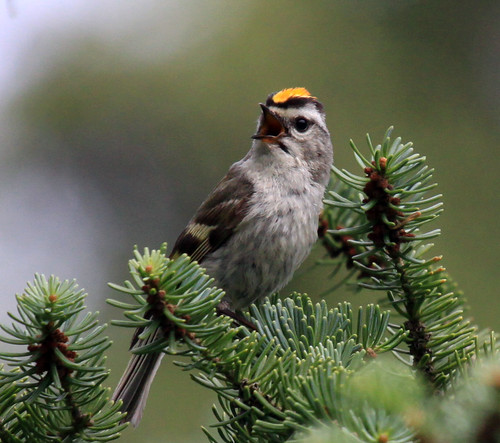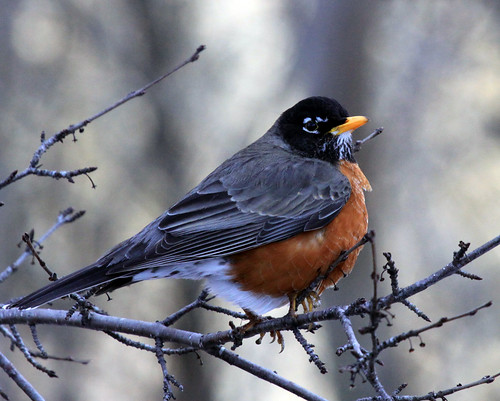 |
| Golden-crowned Kinglet |
Every year or two, I need new eyeglasses. My deteriorating
vision isn’t very noticeable from day to day or month to month, so when I put
on a new pair of glasses, the clarity always surprises and satisfies me. My
near vision is still fairly good, so at home I hardly ever wear glasses. I can
recognize most of my normal birds out the window without glasses or binoculars,
not because I can see any nuances in plumage but because I have so much
experience looking at them that I recognize the usual suspects by size,
behavior, and general color patterns. It’s pretty much the way we can recognize
a stop sign from quite a distance, unless our vision is really bad. We may not
be able to actually read the letters or see the corners to be sure the shape is
an octagon, but stop signs tend to be in the exact same position on street
corners, and no other signs are that color and general shape. My glasses help
me read all kinds of signs, and I can enjoy the nuances of bird plumage,
especially when brought even closer with binoculars.
Although hearing is every bit as important as vision in some
endeavors, from music to birding, we tend to ignore hearing loss way more
easily than we ignore deteriorating vision. For at least a decade, I’ve been
noticing that I’ve lost acuity in my high frequency hearing. I still hear the
vast majority of bird songs other people do, but now can only pick up the
highest frequency songs—Golden-crowned Kinglets, Brown Creepers, Blackburnian
Warblers, etc.—if the birds are very close. Two years ago I actually watched a nearby
Golden-crowned Kinglet singing away, but I couldn’t hear a single note. And last
winter when I was mixing a radio program using a Cedar Waxwing recording I’ve
used many times over the years, I could not hear any of the middle section of
the recording, even though I knew exactly what it was supposed to sound like.
It was time to face up to the truth, and on March 25, I finally did it—I got hearing
aids.
I didn’t know quite what to expect when the audiologist
helped me put them in, but at first I couldn’t even tell if they were working.
In the same way that I can see anything around the house without my glasses,
and nearby things look almost identical with or without my glasses, sounds in
my audiologist’s quiet office sounded virtually identical with and without my hearing
aids. The one thing that was noticeably different was my own voice—I was
hearing it resonating inside my head like always, but also hearing it a bit closer to how it sounds to
other people. Hearing my own voice like that is something I deal with all the
time when producing my radio show, so it didn’t seem like that big of a deal. I’m
sure if my hearing was worse, I’d have appreciated more differences right off,
but for me the immediate change was subtle.
 |
When my mother-in-law and I were leaving her audiologist
after she got hearing aids for the first time, a robin was singing, and she
said that was the first robin she’d heard in years. Oddly enough, she didn’t
think that had anything to do with the hearing aids—she said that robins just
didn’t live around her place in Port Wing, even though I heard them every time
I was there in spring and summer. So far, I’ve never had trouble hearing robins,
but with my hearing aids in, their song is clearer and lovelier again—the way
they were when I was in my 20s. Apparently, little by little I’d lost the high
frequency harmonics that give the song some brilliance, even as I heard the
midtones just fine.
When you get two digital hearing aids with directional
microphones, like mine, the programming allows the hearing aids to work
together to detect and suppress background noise even as they augment bird
songs and human voices. In my own backyard, the basic background
noises—people’s furnaces, chain saws, cars and trucks, wind, doors slamming,
and more—seem to have grown louder as the basic bird songs grew quieter. Now,
with my hearing aids, I feel like I’ve gone back in time to when I was a new
birder, when it was so easy to pick out each different sound. Only it’s even better
now, because I have so much more experience at recognizing the sounds while now
getting so much pleasure in hearing them so clearly again. Like getting a new
pair of glasses, my world is suddenly crisper and more brilliant—only in the
auditory rather than visual realm.
Watching TV is much more enjoyable now, and listening to the
radio in the car is wonderful. The volume and people’s voices don’t sound very
different when I take the hearing aids out or put them back in again, yet with
them in, I hear the enunciation much better. I also hear bird recordings much
more clearly.
Next week my audiologist will be making a few tweaks on the
programming for when I’m using the hearing aids specifically for birding, and
soon the first kinglets, creepers, and waxwings will return so I can test how
well they work for that. I’ll also be testing another kind of hearing aid
specifically designed for birders—one that lowers the frequency of high-pitched
sounds. It’ll be interesting to see which I prefer when looking for
hard-to-hear species like Le Conte’s Sparrows. But so far my bionic ears are a complete
success.
(I have not compared different brands and models of high quality digital hearing aids. Mine are the Phonak Audéo V90.)
(I have not compared different brands and models of high quality digital hearing aids. Mine are the Phonak Audéo V90.)